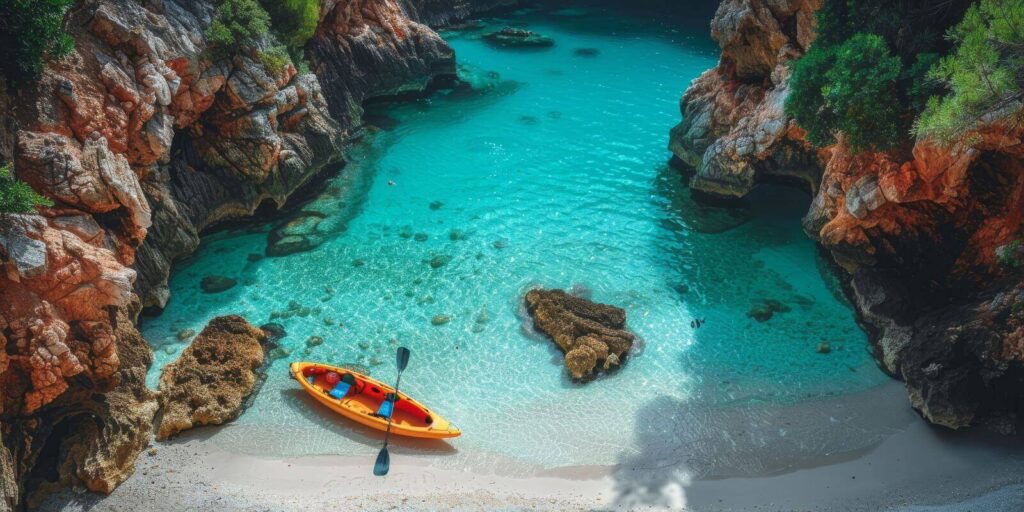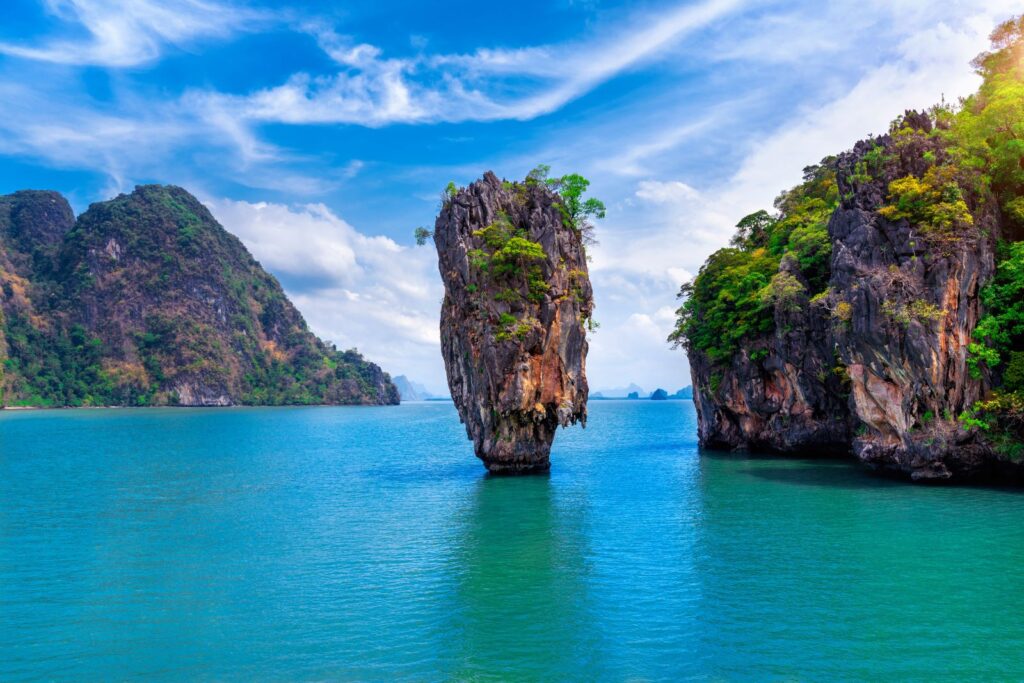Phang Nga Bay, located along the Andaman Sea in Southern Thailand, is a place where nature’s beauty and tranquility converge, offering an unforgettable kayaking experience. With its towering limestone cliffs, hidden lagoons, and crystal-clear waters, this area is a paradise for adventurers looking to explore some of Thailand’s most remarkable landscapes. As a full-time traveler, I’ve kayaked through many incredible places, but Phang Nga remains one of the most unique and magical spots. If you’re ready to paddle through paradise, this guide will take you through everything you need to know about exploring the hidden lagoons of Phang Nga by kayak.

A Glimpse of Phang Nga Bay
If you’ve never heard of Phang Nga Bay, you’re in for a treat. Situated between Phuket and the mainland of Thailand, this bay is famous for its emerald waters, dramatic limestone karsts that shoot up from the sea, and secret lagoons that can only be accessed by kayak. The calm, protected waters make it the perfect spot for kayaking, allowing even beginners to explore at their own pace.
Phang Nga Bay is also home to many small islands, caves, and mangrove forests, offering plenty of opportunities to discover hidden gems off the beaten path. The most famous spot here is James Bond Island, named after its appearance in the movie The Man with the Golden Gun, but trust me, there’s so much more to explore beyond the tourist hotspots.
Why Kayaking in Phang Nga is So Special
One of the best ways to immerse yourself in Phang Nga’s natural beauty is by kayaking. Unlike boat tours, which can sometimes feel rushed, kayaking gives you the freedom to take your time and truly connect with the surroundings. There’s something incredibly peaceful about quietly paddling through narrow limestone canyons, surrounded by towering cliffs and lush greenery, with nothing but the sound of your paddle gently breaking the water’s surface.
Kayaking also allows you to access areas that larger boats can’t reach, especially the hidden lagoons, or “hongs,” that are tucked away behind the cliffs. These lagoons are often only accessible at low tide when small openings in the rock reveal entrances to these secluded paradises. Inside, you’ll find tranquil waters, lush mangroves, and sometimes even wildlife like monkeys, birds, and fish.
Best Time to Kayak in Phang Nga
Timing is everything when it comes to kayaking in Phang Nga. The best time to visit is during the dry season, which runs from November to April. During this time, the weather is sunny, the sea is calm, and visibility is excellent. Plus, you’ll avoid the heavy rains that can sometimes make kayaking difficult during the monsoon season.
However, it’s also important to consider the tides. As I mentioned earlier, some of the hidden lagoons can only be accessed at low tide, so you’ll want to check the tide schedule before heading out. Many tour operators will plan their trips around the tides, ensuring that you get the best experience possible.

Must-Visit Spots in Phang Nga Bay
While the whole bay is stunning, there are a few spots that you absolutely shouldn’t miss while kayaking in Phang Nga. Here are my top recommendations:
1. Koh Panak Island
Koh Panak is known for its caves and hidden lagoons, and it’s a favorite among kayakers. One of the highlights here is the Bat Cave, a dark tunnel that you can paddle through (bring a flashlight!). Once you emerge from the cave, you’ll find yourself in a peaceful lagoon surrounded by high cliffs and dense greenery. The feeling of stepping into this secret world is nothing short of magical.
2. Koh Hong (Hong Island)
Koh Hong is perhaps the most famous lagoon in Phang Nga Bay, and for good reason. The word “hong” actually means “room” in Thai, and it refers to the hidden lagoons that are enclosed by cliffs. Paddling through the narrow entrance to Koh Hong and into the lagoon feels like entering a natural amphitheater. The water here is calm and shallow, making it perfect for a leisurely paddle, and the surrounding cliffs create a sense of peaceful seclusion.
3. James Bond Island
While it’s a bit more touristy than other spots, no trip to Phang Nga would be complete without a visit to James Bond Island (Koh Tapu). The island’s iconic limestone pinnacle is a popular photo spot, and kayaking here offers a different perspective than the crowded boat tours. Paddle around the island and explore the nearby caves and beaches to escape the crowds and enjoy the scenery at your own pace.
4. Koh Yao Noi
If you’re looking for a more laid-back and less crowded experience, head to Koh Yao Noi. This small island is located between Phuket and Krabi, and it’s a great base for kayaking adventures. The island itself is peaceful and relatively undeveloped, with pristine beaches and calm waters. From here, you can kayak to nearby islands, explore mangrove forests, or simply enjoy the slow pace of life.

What to Bring for Your Kayaking Adventure
One of the best things about kayaking is that it’s a relatively low-maintenance activity. However, there are a few essentials that you’ll want to bring along to ensure a comfortable and safe experience:
- Sun Protection: The sun can be intense on the water, so be sure to pack sunscreen, a hat, and sunglasses.
- Waterproof Bag: You’ll want to keep your belongings dry, so a waterproof bag is a must for storing things like your phone, camera, and snacks.
- Water Shoes: Many of the islands and lagoons have rocky or muddy shorelines, so water shoes can help protect your feet when getting in and out of the kayak.
- Plenty of Water: Paddling can be thirsty work, so bring enough water to stay hydrated, especially in the heat.
How to Plan Your Kayaking Trip
If you’re ready to experience Phang Nga by kayak, there are a few different ways to plan your trip. You can either go on a guided tour or rent a kayak and explore on your own. Here’s a quick rundown of both options:
1. Guided Tours
For first-time visitors or those who prefer a more structured experience, a guided tour is a great option. Many tour operators in Phuket and Krabi offer half-day or full-day kayaking tours of Phang Nga Bay. These tours usually include transportation, a guide, and all the necessary equipment, making it a hassle-free way to explore the area. Plus, having a local guide means you’ll learn more about the history, geology, and wildlife of Phang Nga.
2. DIY Kayaking
If you’re more of an independent traveler (like me), you can rent a kayak and head out on your own adventure. There are several places in Phang Nga where you can rent kayaks by the hour or for the day. While this option gives you more freedom, be sure to have a map or GPS and plan your route carefully to avoid getting lost.
Final Thoughts: Kayaking Through Paradise
Kayaking in Phang Nga Bay is an experience that stays with you long after you’ve left. From the stunning limestone cliffs to the hidden lagoons and quiet islands, this part of Thailand offers a unique opportunity to explore nature at its finest. Whether you’re paddling through dark caves, floating in peaceful lagoons, or admiring the dramatic scenery from your kayak, Phang Nga is a paradise for adventurers and nature lovers alike.
So, if you’re planning a trip to Southern Thailand, make sure to add a kayaking tour of Phang Nga to your itinerary. It’s an unforgettable way to see one of the most beautiful corners of the world, and I promise, you’ll never forget the feeling of paddling through paradise.

